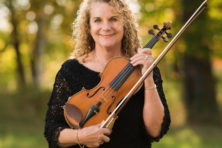Door to Nature
- Share
- Tweet
- Pin
- Share

It is usually around the middle of October that the first broad sweep of 40-degree Fahrenheit autumn “arctic” air sets the aspen leaves to quaking and trembling on their petioles. The subtle hints of yellow provide beautiful contrast with the crisp blue sky. This is grouse weather, the season of the year when many people have their first explosive encounter with one of these bantam-size “chickens of the woods.” Mosquitoes have finally been tamed and the blazing colors of the woods, like blaring trumpets, lure people to these dazzling outdoor palaces.
A great majority of Ruffed Grouse, interrupted during their feast of fall favorites such as acorns, beechnuts, black cherries, clover leaves, highbush cranberries or wild grapes, will reward most of the startled intruders into their domain with nothing more than the whirring sound of their speedy takeoffs.
Once in a great while one of these dauntless little woodland birds utterly dumfounds the human race and actually displays peculiar trust in people. These unexplainable shenanigans, the exact opposite of this bird’s usual and extreme wariness, establish an indisputable fact. Ruffed Grouse are unpredictable creatures.
One of the most astounding and memorable bird experiences Charlotte and I have ever witnessed involved a Ruffed Grouse that took a trust in Mrs. Al Horskey, elderly native of Gills Rock in northern Door County. That perky little daredevil of a chicken-like bird had strutted out of the nearby woods near Mrs. Horskey’s log home and immediately became friends with her.
It was the phone call from Mrs. Horskey telling of the wild bird actually sitting on her lap that prompted our visit, armed with cameras, to the “Top of the Thumb” the next day. The grass was wet with dew when we arrived at her home. Somewhat startled at my knock on the door, she said, “Oh, I’ll call the bird out of the woods so you can take some pictures.
She stood at the edge of the back porch, cupped her hands to her mouth and called over and over, “Here birdie birdie, here birdie birdie!” All I could think of was, “What are we getting ourselves into! Is this lovely lady really serious?”
You can imagine the unbelieving looks on our faces when, big as life, out of the woods comes inching its way forward this perky little Ruffed Grouse. Within minutes Mrs. Horskey had the gorgeous wild creature perched on her lap. We immediately began taking pictures from a distance using medium-range telephoto lenses. Soon we found ourselves having to back up from the little “ham” in order to get it into proper focus. Time after time I would be ready to squeeze the shutter release when the grouse would put its head down and run straight for the big “eye” of the camera. It didn’t appear to be defensive or malicious, just curious.
We noticed the delightful and soft purring and clucking sounds coming from the trusting bird. When the grouse wandered out of sight into the woods, Mrs. Horskey would call for it to return. Soon out would strut “Birdie” ready for more attention.
That endearing once-in-a-lifetime wild bird experience could easily have ended in tragedy whereby the grouse’s uncanny affinity for humans would have led it head on to the business end of a hunter’s 12-gauge shotgun. All we could do was hope for the best, or perhaps even to condition it with scary loud noises, causing it to retreat into the nearby deep thickets and sheltered swamps where it belonged.
Two more similar tame Ruffed Grouse experiences came our way in recent years. Bob and Charlotte Yeomans, who at the time lived close to Northport at the tip of Door County, named their extremely friendly grouse “Reggie.” What at first was “RG,” after Ruffed Grouse, was changed to Reggie. The second excitement of a friendly grouse continues to occur daily with our friends, Bob and Wanda, who live about an hour north of Green Bay, west of Marinette. Of our three Ruffed Grouse experiences, Bob and Wanda’s “Lloyd” is by far the tamest and most trusting. Following careful examination of “Lloyd’s” central tail feathers, we think that Lloyd may be a hen grouse.
All the tail feathers of a cock grouse have a dark band running through them near the tips with few exceptions. It is when the band of the two central tail feathers is pale or blotched that one can assume the bird is a female. However, this method is not nearly foolproof. The entire central tail feathers can also be measured. Those on the male generally are longer than 5 7/8 inches while the female’s are less than 5 ½ inches.
You can also inspect a few plucked feathers from the bird’s lower back, just below the base of the long stiff tail feathers. Count the white or whitish dots. There will be only one white dot on the hen’s feathers while the cock’s will have two or more white dots.
Invariably a Ruffed Grouse experience, glad or sad, inspires me to re-read one of the great wild animal story classics of our time, “Redruff, the Story of the Don Valley Partridge,” by Ernest Thompson Seton, included in his great book, Wild Animals I Have Known.
It was Mrs. Al Horskey who helped us add a thrilling new and memorable chapter to our own concepts of a Ruffed Grouse. After all, how many times have you had a wild grouse come out of the woods and sit upon your lap? And when was the last time you had a grouse around the house?






